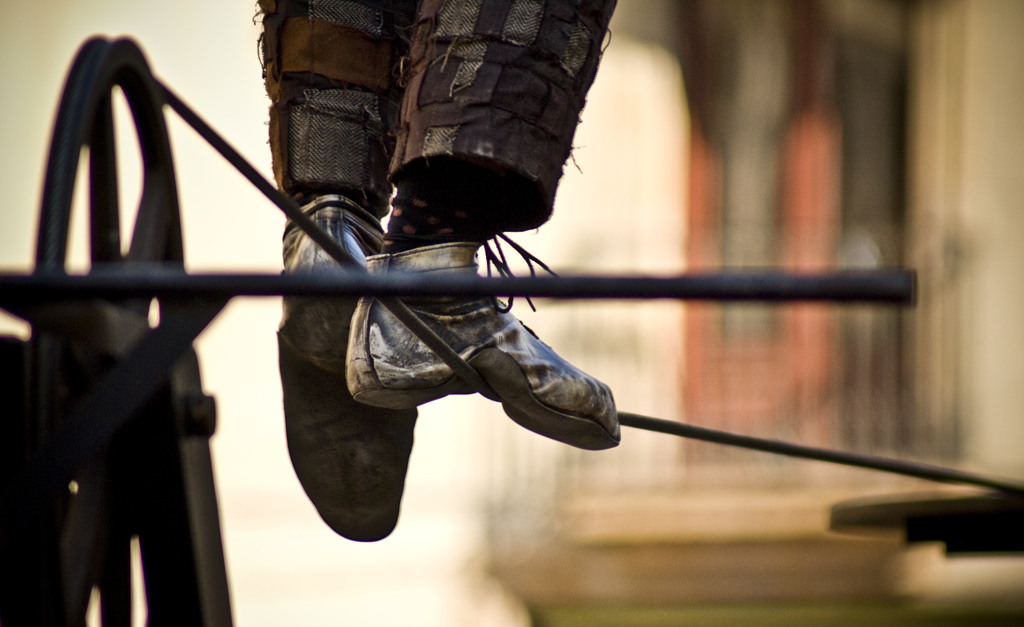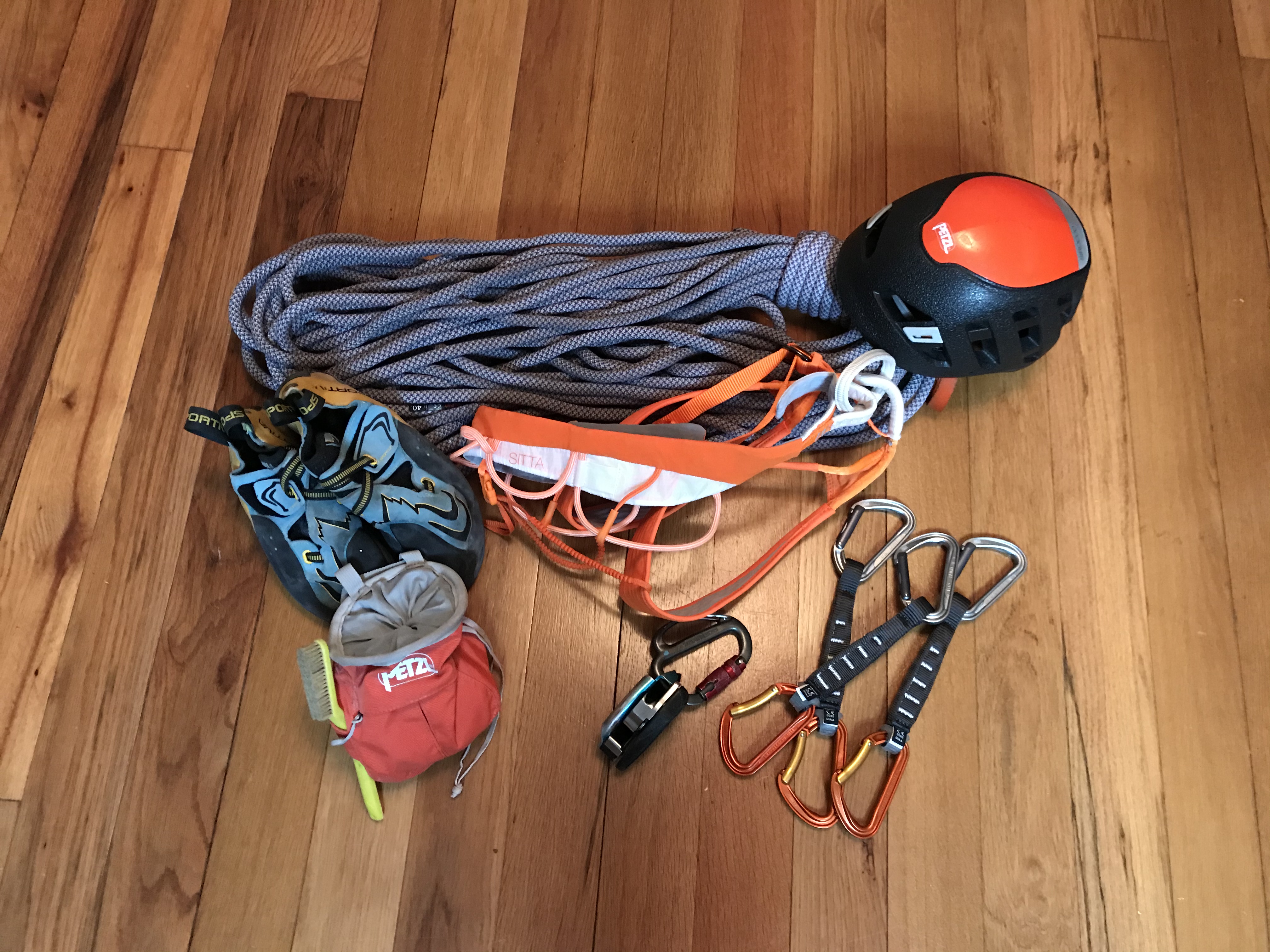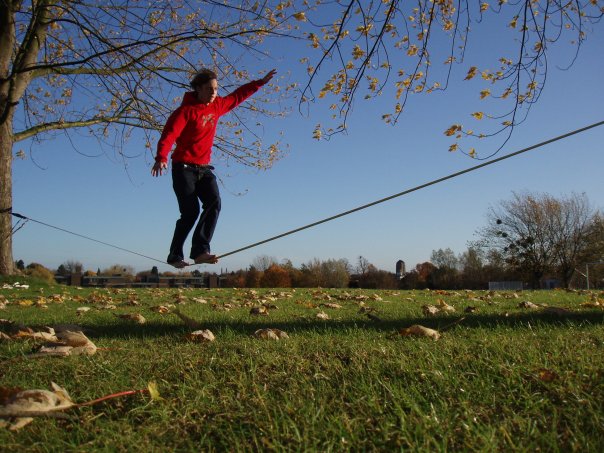|
Philippe Petit
Philippe Petit (; born 13 August 1949) is a French high-wire artist who gained fame for his unauthorized high-wire walks between the towers of Notre Dame Cathedral in Paris in 1971 and of Sydney Harbour Bridge in 1973, as well as between the Twin Towers of the World Trade Center in New York City on the morning of 7 August 1974. For his unauthorized feat above the ground – which he referred to as "le coup" – he rigged a cable and used a custom-made long, balancing pole. He performed for 45 minutes, making eight passes along the wire. Since then, Petit has lived in New York, where he has been artist-in-residence at the Cathedral of St. John the Divine, also a location of other aerial performances. He has done wire walking as part of official celebrations in New York, across the United States, and in France and other countries, as well as teaching workshops on the art. In 2008, ''Man on Wire'', a documentary directed by James Marsh about Petit's walk between the towers, wo ... [...More Info...] [...Related Items...] OR: [Wikipedia] [Google] [Baidu] |
81st Academy Awards
The 81st Academy Awards ceremony, presented by the Academy of Motion Picture Arts and Sciences (AMPAS), honored the best films of 2008 and took place on February 22, 2009, at the Kodak Theatre in Hollywood, Los Angeles beginning at 5:30 p.m. PST / 8:30 p.m. EST. During the ceremony, the Academy of Motion Picture Arts and Sciences presented Academy Awards (commonly referred to as Oscars) in 24 categories. The ceremony was televised in the United States by ABC, and was produced by Bill Condon and Laurence Mark and directed by Roger Goodman. Actor Hugh Jackman hosted the show for the first time. Two weeks earlier in a ceremony at the Beverly Wilshire Hotel in Beverly Hills, California held on February 7, the Academy Awards for Technical Achievement were presented by host Jessica Biel. ''Slumdog Millionaire'' won eight awards, including Best Picture. Other winners included '' The Curious Case of Benjamin Button'' with three awards, ''The Dark Knight'' and ''Milk'' wi ... [...More Info...] [...Related Items...] OR: [Wikipedia] [Google] [Baidu] |
Fencing
Fencing is a group of three related combat sports. The three disciplines in modern fencing are the foil, the épée, and the sabre (also ''saber''); winning points are made through the weapon's contact with an opponent. A fourth discipline, singlestick, appeared in the 1904 Olympics but was dropped after that and is not a part of modern fencing. Fencing was one of the first sports to be played in the Olympics. Based on the traditional skills of swordsmanship, the modern sport arose at the end of the 19th century, with the Italian school having modified the historical European martial art of classical fencing, and the French school later refining the Italian system. There are three forms of modern fencing, each of which uses a different kind of weapon and has different rules; thus the sport itself is divided into three competitive scenes: foil, épée, and sabre. Most competitive fencers choose to specialize in one weapon only. Competitive fencing is one of the five activitie ... [...More Info...] [...Related Items...] OR: [Wikipedia] [Google] [Baidu] |
Jim Moore (photographer)
Jim Moore is an American photographer who has documented the variety arts since the 1970s. His photographs helped Philippe Petit plan his tightrope-walking stunt between the Twin Towers of the World Trade Center in 1974 and were prominently featured in the Oscar-winning film ''Man on Wire''. Life and career Moore studied film at New York University, but found a new calling in corporeal mime when he decided to take classes at the American Mime Theatre. After graduation, he put filmmaking aside and continued taking classes with teachers including Sterling Jensen, a partner of Étienne Decroux. Eventually, he began performing in the street and founded Hudson Street Studio to promote the variety arts. He also began photographing his performer friends at the time, and became a regular contributor to the pioneering rock magazine ''Crawdaddy!'', photographing the Allman Brothers and the Grateful Dead at Summer Jam at Watkins Glen, as well as Jethro Tull, the Rolling Stones, John Mc ... [...More Info...] [...Related Items...] OR: [Wikipedia] [Google] [Baidu] |
Notre Dame De Paris
Notre-Dame de Paris (; meaning "Our Lady of Paris"), referred to simply as Notre-Dame, is a medieval Catholic cathedral on the Île de la Cité (an island in the Seine River), in the 4th arrondissement of Paris. The cathedral, dedicated to the Virgin Mary, is considered one of the finest examples of French Gothic architecture. Several of its attributes set it apart from the earlier Romanesque style, particularly its pioneering use of the rib vault and flying buttress, its enormous and colourful rose windows, and the naturalism and abundance of its sculptural decoration. Notre Dame also stands out for its musical components, notably its three pipe organs (one of which is historic) and its immense church bells. Construction of the cathedral began in 1163 under Bishop Maurice de Sully and was largely completed by 1260, though it was modified frequently in the centuries that followed. In the 1790s, during the French Revolution, Notre-Dame suffered extensive desecration; much of i ... [...More Info...] [...Related Items...] OR: [Wikipedia] [Google] [Baidu] |
David Remnick
David J. Remnick (born October 29, 1958) is an American journalist, writer and editor. He won a Pulitzer Prize in 1994 for his book '' Lenin's Tomb: The Last Days of the Soviet Empire'', and is also the author of ''Resurrection'' and ''King of the World: Muhammad Ali and the Rise of an American Hero''. Remnick has been editor of ''The New Yorker'' magazine since 1998. He was named "Editor of the Year" by ''Advertising Age'' in 2000. Before joining ''The New Yorker'', Remnick was a reporter and the Moscow correspondent for ''The Washington Post''. He also has served on the New York Public Library board of trustees and is a member of the American Philosophical Society. In 2010, he published his sixth book, '' The Bridge: The Life and Rise of Barack Obama''. Background Remnick was born to a Jewish family in Hackensack, New Jersey, the son of Barbara (Seigel), an art teacher, and Edward C. Remnick, a dentist. He was raised in Hillsdale, New Jersey, in a Jewish home with, he has said, ... [...More Info...] [...Related Items...] OR: [Wikipedia] [Google] [Baidu] |
The New Yorker
''The New Yorker'' is an American weekly magazine featuring journalism, commentary, criticism, essays, fiction, satire, cartoons, and poetry. Founded as a weekly in 1925, the magazine is published 47 times annually, with five of these issues covering two-week spans. Although its reviews and events listings often focus on the Culture of New York City, cultural life of New York City, ''The New Yorker'' has a wide audience outside New York and is read internationally. It is well known for its illustrated and often topical covers, its commentaries on popular culture and eccentric American culture, its attention to modern fiction by the inclusion of Short story, short stories and literary reviews, its rigorous Fact-checking, fact checking and copy editing, its journalism on politics and social issues, and its single-panel cartoons sprinkled throughout each issue. Overview and history ''The New Yorker'' was founded by Harold Ross and his wife Jane Grant, a ''The New York Times, N ... [...More Info...] [...Related Items...] OR: [Wikipedia] [Google] [Baidu] |
Tightrope
Tightrope walking, also called funambulism, is the skill of walking along a thin wire or rope. It has a long tradition in various countries and is commonly associated with the circus. Other skills similar to tightrope walking include slack rope walking and slacklining. Types Tightwire is the skill of maintaining balance while walking along a tensioned wire between two points. It can be done either using a balancing tool (umbrella, fan, balance pole, etc.) or "freehand", using only one's body to maintain balance. Typically, tightwire performances either include dance or object manipulation. Object manipulation acts include a variety of props in their acts, such as clubs, rings, hats, or canes. Tightwire performers have even used wheelbarrows with passengers, ladders, and animals in their act. The technique to maintain balance is to keep the performer's centre of mass above their support point—usually their feet. Highwire is a form of tightwire walking but performed at much g ... [...More Info...] [...Related Items...] OR: [Wikipedia] [Google] [Baidu] |
Climbing (sport)
Sport climbing (or Bolted climbing) is a form of rock climbing that relies on permanent anchors (or bolts), permanently fixed into the rock for climber protection, in which a rope that is attached to the climber is clipped into the anchors to arrest a fall; it can also involve climbing short distances with a crash pad underneath as protection. This is in contrast to traditional climbing where climbers must place removable protection as they climb. Sport climbing usually involves lead climbing and toproping techniques, but free solo and deep-water solo (i.e. no protection) climbing on sport routes is also sometimes possible. Since sport climbing routes do not need to follow traditional climbing route lines where protection can be placed into natural features (e.g. cracks), they tend to follow more direct lines up crags. This aspect, in addition to the lack of any need to install protection during the climb (e.g. the sport climber just clips into pre-installed bolts along the ... [...More Info...] [...Related Items...] OR: [Wikipedia] [Google] [Baidu] |
Magic (illusion)
Magic, which encompasses the subgenres of illusion, stage magic, and close up magic, among others, is a performing art in which audiences are entertained by tricks, effects, or illusions of seemingly impossible feats, using natural means. It is to be distinguished from paranormal magic which are effects claimed to be created through supernatural means. It is one of the oldest performing arts in the world. Modern entertainment magic, as pioneered by 19th-century magician Jean-Eugène Robert-Houdin, has become a popular theatrical art form. In the late 19th and early 20th centuries, magicians such as Maskelyne and Devant, Howard Thurston, Harry Kellar, and Harry Houdini achieved widespread commercial success during what has become known as "the Golden Age of Magic." During this period, performance magic became a staple of Broadway theatre, vaudeville, and music halls. Magic retained its popularity in the television age, with magicians such as Paul Daniels, David Copperfield ... [...More Info...] [...Related Items...] OR: [Wikipedia] [Google] [Baidu] |
Washington Square Park
Washington Square Park is a public park in the Greenwich Village neighborhood of Lower Manhattan, New York City. One of the best known of New York City's public parks, it is an icon as well as a meeting place and center for cultural activity. It is operated by the New York City Department of Parks and Recreation (NYC Parks). The park is an open space, dominated by the Washington Square Arch at the northern gateway to the park, with a tradition of celebrating nonconformity. The park's fountain area has long been one of the city's popular spots, and many of the local buildings have at one time served as homes and studios for artists. Many buildings have been built by New York University, while others have been converted from their former uses into academic and residential buildings. __TOC__ Location and features Located at the foot of Fifth Avenue, the park is bordered by Washington Square North (known as Waverly Place east and west of the park), Washington Square East (known ... [...More Info...] [...Related Items...] OR: [Wikipedia] [Google] [Baidu] |
Slacklining
Slacklining refers to the act of walking, running or balancing along a suspended length of flat webbing that is tensioned between two anchors. Slacklining is similar to slack rope walking and tightrope walking. Slacklines differ from tightwires and tightropes in the type of material used and the amount of tension applied during use. Slacklines are tensioned significantly less than tightropes or tightwires in order to create a dynamic line which will stretch and bounce like a long and narrow trampoline. Tension can be adjusted to suit the user, and different webbing may be used in various circumstances. Styles of slacklining Urbanlining Urbanlining or urban slacklining combines all the different styles of slacklining. It is practiced in urban areas, for example in city parks and on the streets. Most urban slackliners prefer wide lines for tricklining on the streets, but some may use narrow () lines for longline purposes or for waterlining. Also see the other sections of sla ... [...More Info...] [...Related Items...] OR: [Wikipedia] [Google] [Baidu] |
Juggling
Juggling is a physical skill, performed by a juggler, involving the manipulation of objects for recreation, entertainment, art or sport. The most recognizable form of juggling is toss juggling. Juggling can be the manipulation of one object or many objects at the same time, most often using one or two hands but also possible with feet. Jugglers often refer to the objects they juggle as ''props''. The most common props are balls, clubs, or rings. Some jugglers use more dramatic objects such as knives, fire torches or chainsaws. The term ''juggling'' can also commonly refer to other prop-based manipulation skills, such as diabolo, plate spinning, devil sticks, poi, cigar boxes, contact juggling, hooping, yo-yo, and hat manipulation. Etymology The words ''juggling'' and ''juggler'' derive from the Middle English ''jogelen'' ("to entertain by performing tricks"), which in turn is from the Old French '' jangler''. There is also the Late Latin form ''joculare'' of Latin ''jocu ... [...More Info...] [...Related Items...] OR: [Wikipedia] [Google] [Baidu] |







